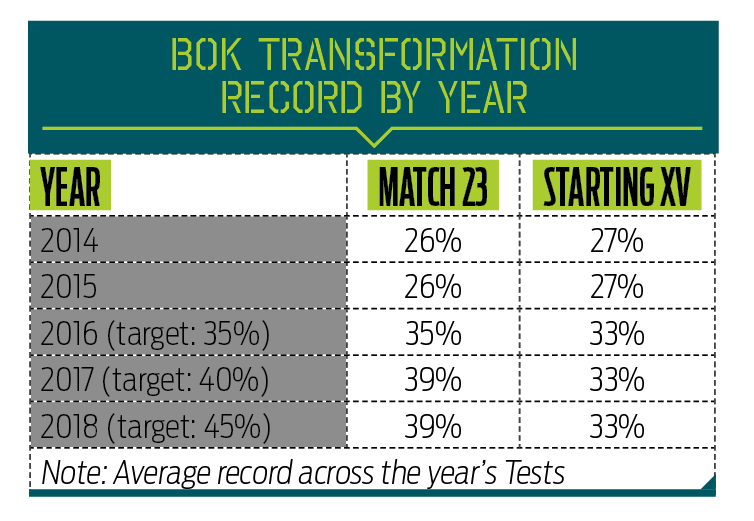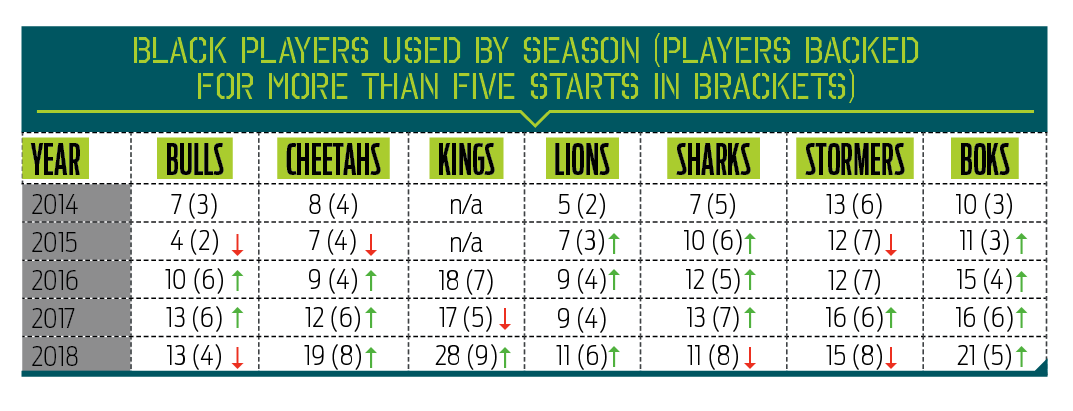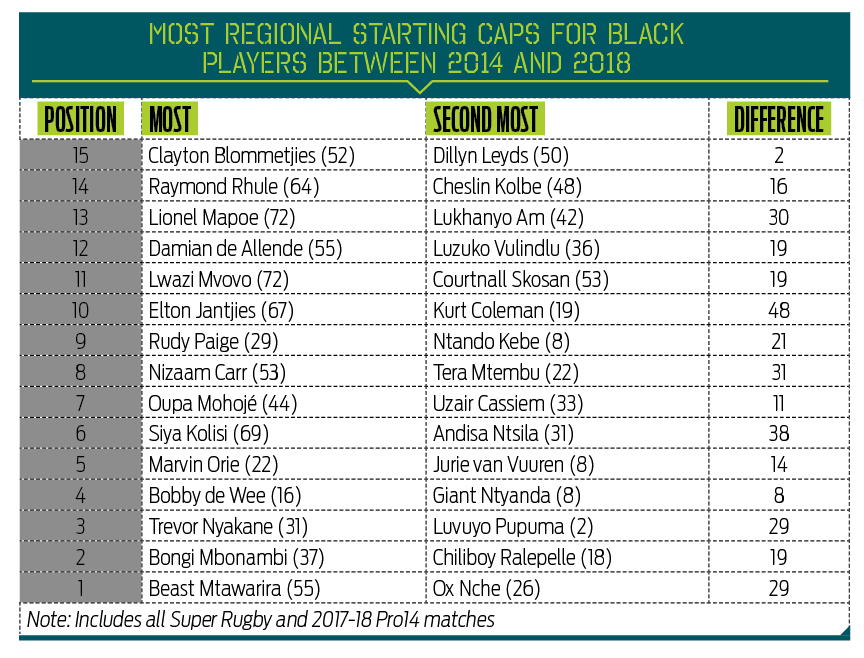While the black player pool has swelled significantly since 2014, SA Rugby’s 50% transformation target remains optimistic, writes JON CARDINELLI.
Mark Alexander’s rhetorical question served as a statement regarding South African rugby’s transformation challenge. ‘How are you going to transform when the bulk of your public schools do not play any form of sport?’
The SA Rugby president was speaking at the launch of the Black Rugby History exhibit at the Springbok Experience rugby museum. Alexander commended the progress made by the national team in 2018, and went on to highlight the problems at the junior levels.
‘The barriers are difficult,’ he lamented. ‘In certain areas you have to take talented kids from previously disadvantaged areas and put them into a rugby school where there is a gym and proper nutrition. Those things count towards becoming a professional rugby player.
‘We see in the Eastern Cape, for example, all those kids know how to play rugby and have a flair for the game, but some of them are not physically capable because of socio-economic issues. They don’t eat well, they don’t have access to gyms. It’s simple things like that. You can run for days on the road, but for rugby, you need strength.’
While that may be true, the pressure is on the South African franchises and the national team to improve their respective transformation records in 2019. Come the World Cup, the Boks must be in a position to field a side that’s 50% black.
It’s a big ask when one considers how the local teams have fared in this department over the past season. It’s worth remembering that the side that represented the Boks at the 2015 World Cup was 74% white and 26% black. Has enough been done at franchise level in the ensuing years to ensure the Boks meet the 50% target at the global tournament in Japan, or is 40% more realistic?
As Alexander has stated, there are various issues to consider when tackling the challenge of transformation. That said, the numbers tell a story about where the top teams have progressed – or in some instances, stalled – since the previous World Cup.
In 2014, the black player pool comprised 40 players – 20 of whom enjoyed more than five starts over the course of the Super Rugby season. With that in mind, it’s little wonder that then Bok coach Heyneke Meyer battled to field more players of colour in the national side.
A total of 97 black players featured for South African teams across the 2018 Super Rugby and 2017-18 Pro14 tournaments. It’s clear to see that the pool of black talent has swelled substantially. As many as 43 of those players were backed to start more than five games. Those numbers suggest that some progress has been made.
Further analysis, however, shows why the Boks are not yet in a position to meet the 50% requirement. It may be some time yet, and may demand a greater investment by the franchises before that goal is realised.
The year 2018 witnessed some important firsts for South African rugby. Siya Kolisi became the first black Bok captain in Test history. Six black Africans featured in the starting team for the first time (against England in Johannesburg).
The Boks fell short, though, in terms of their greater transformation goal – which is made clear in SA Rugby’s Strategic Plan. The target of 45% was met only once in 14 Tests – when the Boks played Wales in Washington DC – and the team finished the season with an average black player representation of 39%.
Alexander came out in defence of Bok coach Rassie Erasmus.
‘We always get blamed for not doing enough, but we will get there. Rassie has done a great job as far as transformation is concerned. We’ve seen the most black players ever in the Springbok team. We also have a black captain. This is long overdue.
‘The target is something that must not come from transformation, but naturally. These players are good enough to be there. Nobody can name one of the players and say that they are there because they are quotas.’
Erasmus told SA Rugby magazine earlier in 2018 that he expected to fall short of the requirement for the year.
‘We have a long-term plan. I don’t think we will get everything right by December,’ he admitted. ‘We’re probably not going to hit that 45% target every weekend [at the South African franchises and at the Boks] but in terms of our average over the next couple of years, I think we’ll get there eventually.’
Erasmus was frank about his responsibility as the Bok coach and director of rugby. As a former coach of the Cheetahs and Stormers, he said that he understood the pressures of managing a local franchise and specifically the challenges around transformation.
At the same time, Erasmus made it clear that local coaches who didn’t contribute to the transformation cause would be looking for alternative employment sooner rather than later. Every elite coach in the country should, in theory, be working together to ensure that the Boks field a side that is both strong and representative at the World Cup.
SA Rugby moved to implement its Strategic Transformation Plan in late 2014. When one compares the transformation records of the franchises four years ago with what was achieved in 2018, it’s evident that every team has contributed – albeit to varying degrees.
Erasmus gave a host of black and white players opportunities in 2018 with the aim of developing a wider squad ahead of the 2019 World Cup, and in that respect it may not surprise many people to note that 21 black players were used across the 14 Tests.
It is significant, though, that more black players were backed to start – Kolisi, Aphiwe Dyantyi, Lukhanyo Am and S’bu Nkosi, to name a few – and a concerted effort was made to nurture youngsters like Damian Willemse with the future in mind. Compare the current situation to that of 2014, where the starting black contingent was usually limited to two wings and a prop.
Of course, one only needed to look at the makeup of the respective franchises to understand why so few black players were backed by the Boks in 2014. Four years on, and the situation has improved at franchise and national levels.
The Kings have made use of the exciting black talent in the Eastern Cape since their return to the top flight in 2016. The Sharks and Stormers have been consistent contributors on the transformation front. While many of the black players representing the coastal franchises have roots in the Eastern Cape, some credit is due to the Sharks and Stormers coaches when one considers that 12 such players (out of 21) went on to play for the Boks in 2018.
The Bulls and Lions are using more black players now than was the case four or five years ago. That said, when one compares those records to those of the other franchises, one has to ask if the teams from Gauteng should be doing more for the transformation cause.
Former Bulls coach John Mitchell backed only four players of colour to start regularly over the course of the 2018 season. Some South African rugby fans have argued that the drive to transform local teams is having a negative impact on results. How then do they explain the fact that the least transformed side finished last in the South African conference and 12th overall?
Earlier in 2018, Erasmus confirmed that one of the aims of the Strategic Transformation Plan was to develop quality players in every position. As was the case five years ago, the Boks are spoiled for choice in the back three. The situation has improved a great deal, though, with regards to the options in the forwards.
Again, it’s worth looking at how many caps, and more specifically how many starts, those players have enjoyed in recent times. While there will be exceptions, the Bok coach is likely to select players – black and white – who are starting regularly for their franchises at Super Rugby and Pro14 levels.
Consider the black players who started the most games between 2014 and 2018. The backs with the most starts are household names. Seven of the eight forwards on that list have represented the Boks.
The point regarding the worrying lack of depth is made, though, when one draws up a second team comprising players with the next-best starting record. The gap between Elton Jantjies (67) and the flyhalf with the second-most starts (Kurt Coleman, 19) is gargantuan. More needs to be done to develop the black halfbacks, locks and tighthead props in South Africa, either by recruiting and nurturing players at the lower levels or backing those in the elite squads more consistently.
What we witnessed in 2018 was a number of franchises playing the top black players into the ground. Jantjies, Kolisi and Beast Mtawarira are but three who could have used a break during the Super Rugby season. As Alexander has rightly said, these players have been selected on merit and their inclusion improves a team’s chances of winning.
When will those teams boast the necessary depth that allows them to rest key players and meet transformation objectives? Coaches may be tempted to push these players over the course of a season rather than develop alternatives. This will compromise the top black players and ultimately the Boks’ ability to meet the requirements in the lead-up to the World Cup, though.
ALSO READ: Madiba wouldn’t support quotas – Kolisi
Transformation remains a complicated issue. There is reason to celebrate when one considers how far the teams have come since 2014. Six black Africans – all selected on merit – started against England this past June, and contributed in no small part to an important victory. It’s encouraging to think about where South African rugby may be in another five years as far as the black player pool is concerned.
At the same time, it’s clear that some franchises are contributing more than others with regard to player development. Too few black players are backed to start consistently at Super Rugby level. For example, Embrose Papier could certainly have done with more than three starts for the Bulls before he graduated to the Boks.
The issue around player welfare will only serve to complicate matters further in the coming years. Prominent black players cannot be expected to play every game for franchise and country. With this in mind, franchises can’t go into a competition with a wider squad that is more than 70% white – as the Bulls and Lions did in 2018.
As Alexander has stated, the problems at grassroots level need to be addressed. The junior structures – particularly in regions like the Eastern Cape – have to be fixed to ensure that players are in position to succeed when they graduate to the senior level. As director of rugby and a self-professed advocate of transformation, Erasmus must make this a priority, sooner rather than later.
– This article first appeared in the January 2019 issue of SA Rugby magazine.
Photo: Clive Rose/Getty Images








